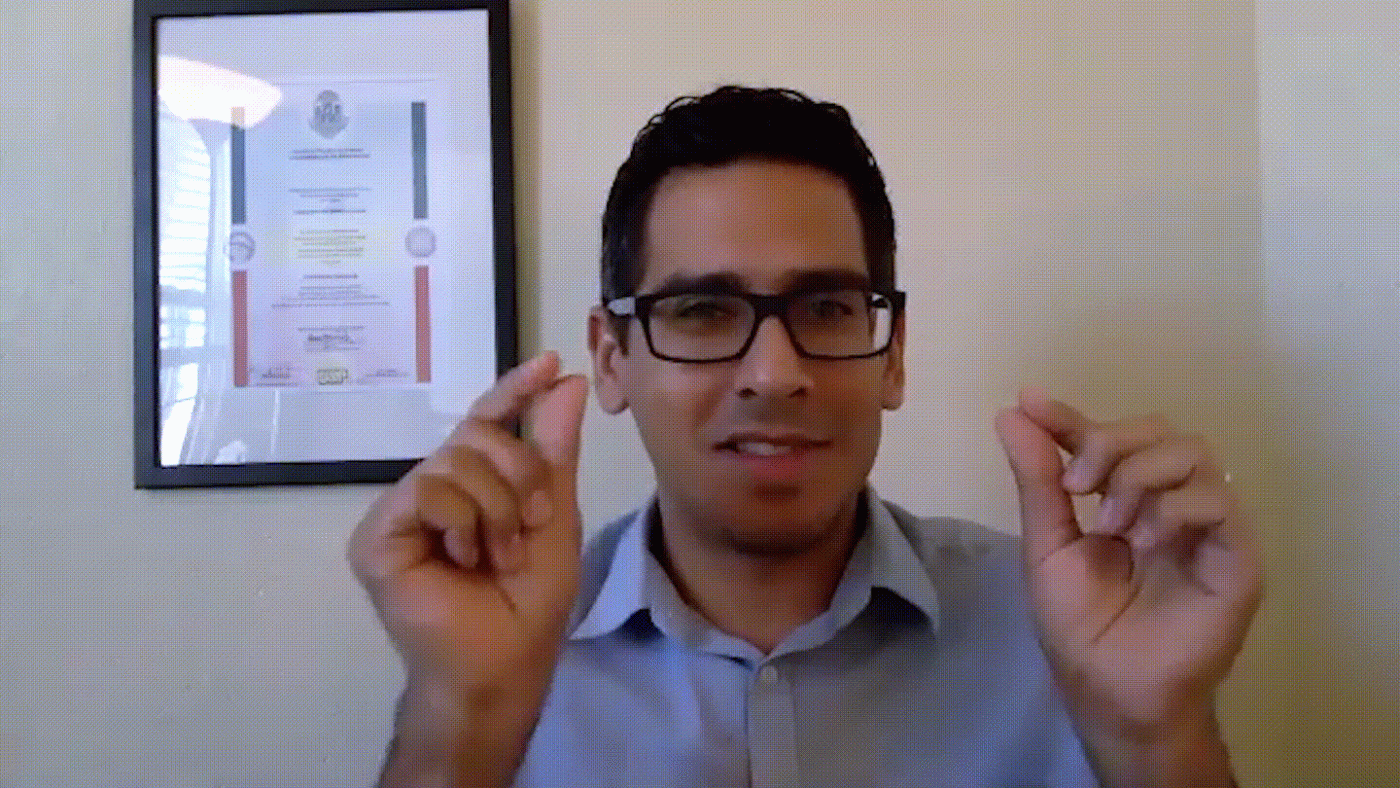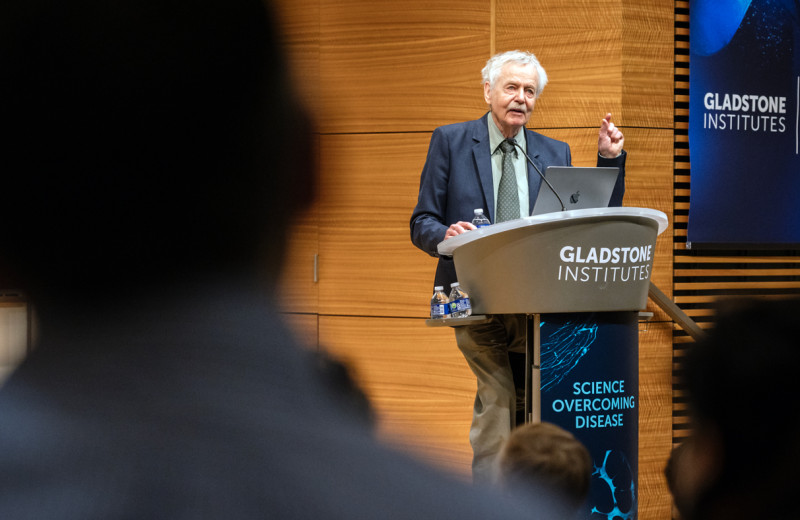Gladstone NOW: The Campaign Join Us on the Journey✕

Originally from Brazil, Leandro Lima, PhD, is a bioinformatician in the Bioinformatics Core and the Finkbeiner Lab. During the COVID-19 pandemic, he’s been spending more time skateboarding with his two-year old and preparing for a new baby to arrive.
What brought you to Gladstone?
I joined Gladstone 4 years ago in September 2016 and was studying transcriptomes and Parkinson’s disease. After some time, I started to work more with genomics and joined the ALS research group. I’ve done a lot of work with machine learning.
Can you describe your current research project?
I mostly study ALS and Parkinson’s disease.
Right now, we’re trying to find variants, or differences, within the genome that could be associated with the disease Amyotrophic lateral sclerosis (ALS). If we thought about our genomes as books, the chromosomes would be the pages. Each page contains letters that form words. In the genome, the alphabet consists of the letters A, C, G, T. In diseases, such as ALS, some people have missing or duplicated letters that cause interference in our bodies. We’re looking for individual letters that could be causing the disease.
For most people, our “books” are the same because that’s what makes us humans, but there are tiny parts that are different. For instance, certain genes within the genome change your height or color of your hair, but unfortunately, some can cause disease.
So our team is comparing the “books” of people with ALS with people who are healthy, to try and understand what causes ALS. We use computer science and statistics to create programs that can read immense amounts of data because the number of gene comparisons that we have to do is too large for a human to analyze. We take people’s DNA data as huge text files (generated by genome sequence platforms) and we use tools that will transform the information in a way that can be analyzed by machine learning algorithms. From this, we try to find patterns or relationships between the letters and the disease.
It’s hard to find because not everyone with the disease has the same genomic variations. And that’s the challenge of the research.
Were you interested in science as a child?
I was always interested in science. I really liked math and I’ve always been interested in how to solve problems using mathematics or computer science.
What increased my interest in bioinformatics was when I was getting my bachelor’s degree, studying how to design algorithms, and we saw a technique called dynamic programming. This technique is used to compare genome sequences and we can apply that to DNA because in bioinformatics, we were comparing sequences, all the time.
So, I thought, ‘Oh, that’s interesting! We can use computer science to understand biology.’ After that I immersed myself more and more into biology and how to use computer science to solve biological questions.
What made you decide to go to graduate school?
It was really the idea that I could learn more. The more you learn, the more you realize that you don’t really know that much. Seeking a challenge that could help human health, I thought it would be interesting to study more difficult biological problems.
So that led me to study biological networks, and combining DNA studies with biological network theory is what I would do to obtain my PhD.
How has the pandemic changed your work?
I had actually gone to Brazil in March for my brother’s wedding and we were planning to spend 2 weeks there. The following week, all the flights were canceled. I thought, okay this will just be for a few weeks. But it was finally 2 months later when we were able to come back to the US and that was right before the travel ban from Brazil. So, we were lucky.
Since then, I’ve been working from home the whole time—all the work I do uses a computer.
But I miss seeing my colleagues at Gladstone. There’s a lot of people, who only recently joined the lab, that I’ve actually never met in person. It’s been interesting to start working more closely with someone that you’ve never met in person. Fortunately, the Bioinformatics Core has lunch together (virtually) and they organize happy hours, so that’s been a healthy way to stay connected while working from home.
How have you been spending your time during shelter-in-place?
I’ve been spending a lot more time playing online chess.
But overall, I’ve been spending more time with my family. I have a two-year-old and we’ve been skateboarding together. My wife and I are also expecting a new baby, so I’ve been spending more time with the family.
What do you like most about your job?
I’m learning all the time. I’m learning new techniques which is really good because I’m never doing the same thing.
I work with different diseases and different techniques all the time. So sometimes I study DNA, sometimes RNA, sometimes it’s just biological networks. It’s all connected but it’s all different at the same time.
What influenced your decision to work in science?
I went into science because I like challenges. I like to study and learn new things constantly and in science you can do that.
Also knowing that I can use my knowledge in computer science to have an impact on people’s lives.
If you could learn to do anything, what would it be?
I used to surf in Brazil, but I was never a good surfer. So, I think I’d like to learn how to surf well and learn to snowboard.
Do you have any hidden or unique talents?
I can solve the Rubik’s Cube and I know some magic tricks.
If you could meet any scientist from any point in time, who would it be and why?
I’d like to meet Alan Turing because of his contributions to computer science in general. He overcame a lot during his lifetime.
How has your heritage shaped your career?
Being a scientist from Brazil can be a bit of a challenge sometimes. First of all, you have to learn a new language to come and work in the US.
Sometimes people think you’re not good enough because you’re not from a top US university. You have to prove yourself because nobody knows the schools that you’re coming from. So, you have to prove that you know how to do your work.
I would say I’m a bit shy but Brazilians in general like to make connections. We like to hug and talk a lot. This has allowed me to meet more people and break the ice. People also usually really like Brazil so that’s often a good conversation starter.
Why do you think Latinx representation is important?
When you meet scientists and see people like you, you will always know that you can do what they’re doing—no matter your color or the place you come from.
Want to Join the Team?
Our people are our most important asset. We offer a wide array of career opportunities both in our administrative offices and in our labs.
Explore CareersA Sculptor of Modern Regenerative Medicine
A Sculptor of Modern Regenerative Medicine
Among his myriad accomplishments, Rudolf Jaenisch—winner of the 2025 Ogawa-Yamanaka Stem Cell Prize—was the first to demonstrate the potential of induced pluripotent stem cells to treat disease.
Awards Ogawa Stem Cell Prize Profile Regenerative Medicine Stem Cells/iPSCsMeet Gladstone: Shijie Wang
Meet Gladstone: Shijie Wang
Shijie Wang, a postdoctoral scholar in Steve Finkbeiner’s lab, uses artificial intelligence, robotics, and stem cell technologies to uncover how brain cells die in neurodegenerative diseases like Alzheimer’s and Parkinson’s.
Profile Neurological Disease Finkbeiner Lab AI Robotic MicroscopyMeet Gladstone: Oscar Yip
Meet Gladstone: Oscar Yip
Oscar Yip is advancing Alzheimer’s research in Yadong Huang’s lab at Gladstone while drawing inspiration from his family, community, and his broader goal of helping patients.
Graduate Students and Postdocs Profile Alzheimer’s Disease



